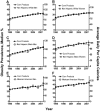Survey of American food trends and the growing obesity epidemic
- PMID: 21779530
- PMCID: PMC3133759
- DOI: 10.4162/nrp.2011.5.3.253
Survey of American food trends and the growing obesity epidemic
Abstract
The rapid rise in the incidence of obesity has emerged as one of the most pressing global public health issues in recent years. The underlying etiological causes of obesity, whether behavioral, environmental, genetic, or a combination of several of them, have not been completely elucidated. The obesity epidemic has been attributed to the ready availability, abundance, and overconsumption of high-energy content food. We determined here by Pearson's correlation the relationship between food type consumption and rising obesity using the loss-adjusted food availability data from the United States Department of Agriculture (USDA) Economic Research Services (ERS) as well as the obesity prevalence data from the Behavioral Risk Factor Surveillance System (BRFSS) and the National Health and Nutrition Examination Survey (NHANES) at the Centers for Disease Control and Prevention (CDC). Our analysis showed that total calorie intake and consumption of high fructose corn syrup (HFCS) did not correlate with rising obesity trends. Intake of other major food types, including chicken, dairy fats, salad and cooking oils, and cheese also did not correlate with obesity trends. However, our results surprisingly revealed that consumption of corn products correlated with rising obesity and was independent of gender and race/ethnicity among population dynamics in the U.S. Therefore, we were able to demonstrate a novel link between the consumption of corn products and rising obesity trends that has not been previously attributed to the obesity epidemic. This correlation coincides with the introduction of bioengineered corns into the human food chain, thus raising a new hypothesis that should be tested in molecular and animal models of obesity.
Keywords: Obesity; bioengineered; corn product; food trend; genetically modified.
Figures





References
-
- Kelly T, Yang W, Chen CS, Reynolds K, He J. Global burden of obesity in 2005 and projections to 2030. Int J Obes (Lond) 2008;32:1431–1437. - PubMed
-
- Flegal KM, Carroll MD, Ogden CL, Curtin LR. Prevalence and trends in obesity among US adults, 1999-2008. JAMA. 2010;303:235–241. - PubMed
-
- Atkinson RL. Viruses as an etiology of obesity. Mayo Clin Proc. 2007;82:1192–1198. - PubMed

